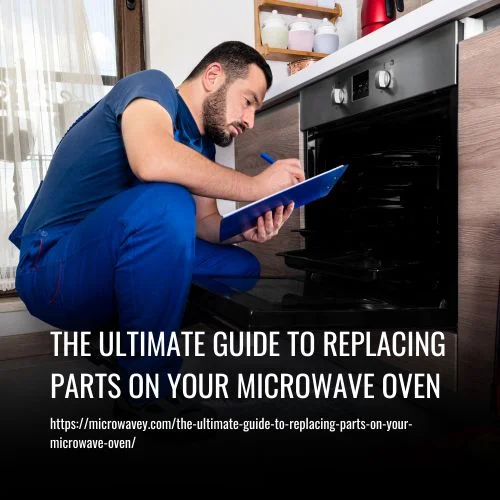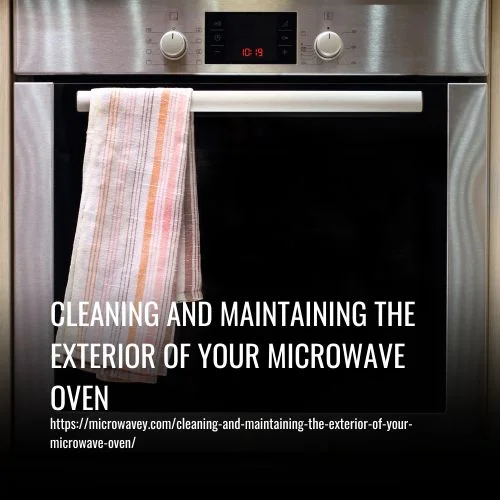The Ultimate Guide to Replacing Parts on Your Microwave Oven
Replacing parts on your microwave oven may seem like a daunting task, but it’s really not that difficult. If you have the right tools and supplies, plus the knowledge of what to do and how to do it, then you can replace most parts with relative ease.
As an appliance repair expert with decades of experience in this industry, let me tell you what you need to know about replacing parts on your microwave oven.
First off, always make sure you purchase quality replacement parts for your oven from reliable sources. It’s important that these parts are designed specifically for your model so they will fit properly and work correctly.
Additionally, double-check that any instructions or instructions manuals supplied with the new part are clear and easy to understand. Taking the time to read through them thoroughly before attempting installation could save you a lot of headaches down the road!

Safety Guidelines
Wow, have you ever been in the middle of cooking a meal and heard that dreaded sound coming from your microwave? It can be a real hassle to figure out what is going on with it.
But don’t worry — as an appliance repair expert, I’m here to help walk you through replacing parts on your microwave oven safely.
When handling any type of electronic component, safety should always come first! Make sure you are wearing proper protection like gloves and eyewear when working with sensitive components or wiring.
Additionally, remember to unplug the unit before attempting anything more than basic maintenance. With these simple tips in mind, you will be well-equipped to replace any part needed for your microwave oven without putting yourself at risk.
Tools And Supplies Needed
Now that you know the safety guidelines for replacing parts on your microwave oven, it’s time to learn about the tools and supplies needed. Before attempting any repairs or replacement of parts, make sure you have all the necessary items on hand.
Here is a list of what I recommend having before starting any repair job:
- Replacement Parts – Make sure you get the right part number when finding replacements. This can be done by contacting your manufacturer or looking up online resources.
- Installation Tools – Have screwdrivers, pliers, wire strippers, an anti-static wrist strap (if available) and other small tools handy for installation purposes.
- Cleaning Supplies – You will need cleaning products such as degreasers and sanitizers to clean out old components if they are being replaced.
- Protective Gear – Safety glasses, gloves, and work boots should always be used while working with electrical appliances in order to protect yourself from potential hazards like electric shocks.
Knowledgeable DIYers can save themselves some money by successfully completing their own appliance repairs using these suggested tools and supplies. With proper preparation and dedication to safety protocols, anyone can confidently take on this task!
Locating The Faulty Part
As an appliance repair expert, I’m often asked how to replace parts on a microwave oven. The process of replacing the part is not difficult when you know what you’re doing and why it needs to be done. Here’s what I recommend for locating the faulty part:
| Task | Description |
|---|---|
| Identifying Problems | Check that the power cord and outlet are working properly. Unplug the unit before making any repairs. Ensure all safety precautions are taken. |
| Ordering Parts | Locate the model number and serial number located inside or on back of oven to order correct replacement parts online or at a local store. Make sure they fit your machine correctly by double checking measurements, voltage ratings, etc. |
After identifying and ordering the correct replacement parts, it’s time to prepare them for installation in your microwave oven. Before beginning this process make sure that unplugging the unit has reset any fuse breakers and if necessary contact a certified technician to help with more complicated tasks such as wiring work or soldering connections. Now you can begin replacing those faulty parts!
Uninstalling The Old Part
Well, this is it folks – the moment of truth. It’s time to take off those gloves and get your hands dirty; we’re going in!
The first step is disconnecting any cables that are connected to the old microwave part. Don’t worry if you don’t know what all goes where; just remember which ones were plugged into the part and label them appropriately.
Once everything has been unplugged, it’s time for some good old fashioned screw removal action! Make sure to keep track of each screw as you go so you can use them when installing the new part.
And there you have it: with a few simple steps, you’ve successfully removed your old microwave part and now have an open canvas ready for a fresh start.
Now let’s move on to the next section – installation of the new one – and get this party started!
Shopping For A New Part
Researching part compatibility is key when shopping for a new part. To ensure you’re getting the right part for your microwave oven, double-check its model number to make sure the part you’re purchasing is compatible. I always recommend online research to verify compatibility before making a purchase.
When you’re ready to buy the part, make sure to check the return policy and shipping times. This will help ensure you get the part you need quickly and efficiently.
Installing a new part in your microwave oven safely is extremely important. Pay attention when following the installation instructions, and be sure to take all necessary safety precautions. If you’re not confident in your abilities, it may be best to contact a professional for assistance.
Researching Part Compatibility
When shopping for a new part, I always recommend researching part compatibility by looking at the schematic diagrams and reviewing instructions. This way you can be sure that the part you buy will fit your microwave oven.
To make it easier to find what works for your model, use manufacturers’ websites or contact customer service directly. That way you won’t waste money on parts that don’t work with your particular appliance.
A little bit of extra research can save you time and headache down the line. So don’t skimp when replacing parts – do your homework!
Purchasing The Right Part
Once you’ve done your research and identified the right part for your appliance, it’s time to find a supplier.
You’ll want to evaluate the quality of their products, so look into customer reviews or ask around in online forums.
It’s also wise to research suppliers by checking out their credentials and viewing any accreditation they may have earned.
By taking this extra step, you can be sure that when you purchase from them you’re getting reliable parts of good quality.
Installing The Part Safely
Now that you have the right part and a reliable supplier, it’s time to get ready for installation.
It’s important to take proper safety precautions when dealing with electrical appliances and parts, so make sure you have all the necessary protective gear before starting work.
Take care of any potential hazards and be aware of possible electrical shocks or malfunctions that could occur during installation.
With the proper protection in place, you’ll be able to install your new part safely and efficiently!
Installing The New Part
It’s important to take safety precautions when replacing parts on your microwave oven. Make sure that you’re unplugging the appliance and leaving it off throughout the process. Additionally, be mindful of any sharp edges or exposed wiring while handling the machine.
When selecting a part for replacement, make sure that you choose one that is compatible with your specific microwave model. Cross-referencing an OEM (Original Equipment Manufacturer) part number will help confirm compatibility before you purchase anything.
If needed, reach out to customer service for assistance in finding the right part for your needs. Ultimately, having all of this information ready beforehand helps ensure success when performing repairs yourself.
Testing The New Part
Replacing parts on your microwave oven is no joke! It’s like you’re performing open-heart surgery, but with a lot less blood.
But don’t worry – I’m here to help guide you through the process one step at a time.
Once you’ve successfully installed and replaced the part in question, it’s time for the most important part of all: testing.
To ensure that the new part is working properly, power and temperature tests are essential.
If either test fails, then it means that something has gone wrong during the installation or replacement phase and needs to be corrected immediately.
A successful combination of both tests indicates that the new part has been correctly installed and can now perform its duties as expected.
So there you have it – an overview of how to replace parts on your microwave oven safely and proficiently!
With this knowledge under your belt, nothing should stop you from getting those appliances humming again in no time flat.
Troubleshooting Common Issues
If you’re having trouble with your microwave oven, don’t panic! Troubleshooting common issues can be easy and straightforward when you know the right techniques.
Here are a few tips to help guide you through problem diagnosis:
- Check that all connections are secure and properly aligned.
- Make sure that all parts have been installed correctly.
- Test the power supply to ensure it is providing adequate voltage.
- Take note of any unusual noises or smells while using your appliance.
- Consult user manuals for guidance on specific components or settings if needed.
With these tools in hand, you’ll be able to identify most problems quickly and accurately before deciding whether or not replacing parts is necessary.
If a replacement part is required, make sure to purchase one specifically designed for your make and model of microwave oven so that it fits securely into place without additional tinkering or adjustment. This will significantly reduce the chances of any further complications arising from improper installation.
Reassembling The Oven
Once you have identified and replaced the faulty components of your microwave oven, it is time to reassemble the appliance.
When reassembling, start with the power supply first as this is a key component that must be secured correctly in order for your oven to operate safely. Make sure all wiring is connected properly and ensure that any cables are taped securely into place.
Next, replace any door hinges or clips if they had been removed previously during troubleshooting and make sure they fit snugly against the frame of the oven without leaving gaps when closed. Finally, inspect each part before putting them back together again.
This will help identify any additional issues that may need attention such as loose screws or worn-out parts which could cause further problems down the line. Take extra care when replacing delicate components such as light bulbs and fuses – making sure these are firmly attached so there won’t be any unexpected breakdowns later on.
Preventive Maintenance Tips
When it comes to protecting the components of your microwave oven, preventive maintenance is key. A little regular cleaning and care can go a long way towards preventing damages or costly repairs.
I’m talking about things like wiping down surfaces with a damp cloth after every use, checking seals on doors for cracks or tears, and making sure vents are free from obstructions. These small steps will help save you time and money in the long run by warding off potential problems before they become serious ones.
But what happens if something does break? Well, it’s important to know that many parts inside an oven are replaceable– but only if you have the right tools at hand!
The first step should be finding out which part needs replacing; oftentimes this information can easily be found online. Then make sure to source quality replacement parts from reliable suppliers so that your project goes smoothly without any hiccups along the way.
With these tips in mind, you’ll soon find yourself as an expert-level appliance repair technician!
Frequently Asked Questions
How Much Does It Cost To Replace Parts On A Microwave Oven?
When it comes to replacing parts on a microwave oven, many people are hesitant due to the cost. DIY repairs can be expensive, and if you don’t have the right tools or experience, they might not even work properly in the end. That’s why I recommend that anyone considering doing their own microwave repair should take safety into account first.
Even though there is some risk involved with DIY appliance repairs, it doesn’t mean that they aren’t possible. With the right knowledge, tools and patience, you can replace parts on your microwave oven without breaking the bank!
Is It Easy To Find Replacement Parts For My Model Of Microwave Oven?
Searching for the right replacement parts to give your microwave oven a new lease of life can be like looking for a needle in a haystack, but with online shopping and installation guides available it doesn’t have to be an uphill battle!
Whether you’re wondering if finding components for your model is easy or not, rest assured that there are plenty of resources out there.
As an appliance repair expert I’m here to tell you that you can find what you need without too much hassle – just make sure to double check compatibility before ordering anything online.
How Long Does It Take To Replace A Part On A Microwave Oven?
Replacing a part on your microwave oven can take anywhere from 10 minutes to an hour, depending on the complexity of the part you are replacing.
It is important that you take safety precautions before attempting any repair job so make sure to read through all instruction manuals and check out YouTube tutorials if needed.
As an appliance repair expert, I suggest taking extra care when handling electrical components and making sure you are familiar with the model of microwave oven you have in order to find replacement parts easily.
Are There Any Special Instructions I Need To Follow When Replacing Parts On My Microwave Oven?
Replacing parts on your microwave oven is like a jigsaw puzzle. It’s important to make sure you have all the right pieces before getting started, and that includes researching your purchase options as well as safety measures.
As an appliance repair expert, I recommend following special instructions when replacing any part of your microwave oven – not just for accuracy but also for your own personal safety! Make sure to read up on how-to guides or consult with a professional if needed to ensure everything goes smoothly.
Do I Need Any Special Skills Or Tools To Replace Parts On My Microwave Oven?
When replacing parts on your microwave oven, do you need any special skills or tools?
Yes and no. Depending on the part you’re replacing, it may require some DIY knowledge so safety precautions can be taken.
For example, if you have to replace a capacitor, it’s best that you know how to discharge it properly first.
On the other hand, smaller components such as bulbs might not necessitate more than basic screwdriver work – just remember to unplug your appliance before doing any repairs!
As far as cost goes, unless you’re buying new replacement parts from the manufacturer, repair costs should stay relatively low.
Conclusion
Replacing parts on a microwave oven is not as difficult or expensive as you may think. By understanding the basics of DIY appliance repair, and having the right tools and skills, you can replace any part yourself with ease.
Take for instance my client’s case: She had an old microwave oven that was no longer working properly due to a faulty fan motor. After doing some research online she found the correct replacement part and decided to attempt replacing it herself.
With just a few basic hand tools, I guided her through step-by-step instructions over the phone, helping her successfully complete the job in under an hour!
So if your microwave oven is malfunctioning or has stopped working altogether then don’t be intimidated by trying to fix it yourself. With minimal effort and dedication you can have your appliance up and running again in no time – all while saving money from costly repairs.
Replacement parts are easily available online so why wait? Get started now on restoring your beloved kitchen gadgets today!






